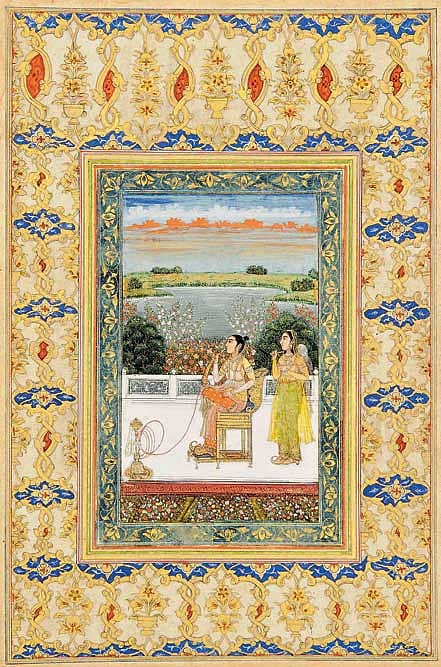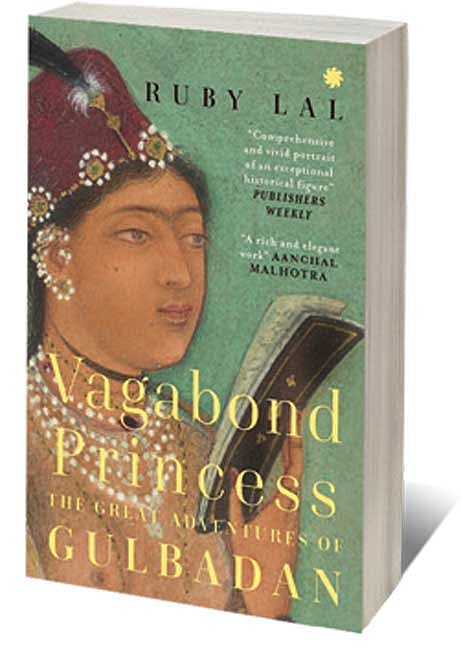Free Spirit

DAUGHTER OF BABUR, and beloved sister to Humayun, Gulbadan lived an unusually adventurous life—one most would not expect for a 16th-century Mughal princess. She was 52 when she successfully negotiated a pilgrimage for herself and a coterie of other women from Fatehpur Sikri to Mecca—an odyssey over land and sea that would take months. Twelve years later, her nephew, Akbar the Great, would ask her, among others, to write a history of the Mughal dynasty. She was the one woman invited to do so. Her manuscript, Ahval-i Humayun Badshah, is the only work of prose written by a woman of the Muslim courts.
Ruby Lal, a historian with a decades-long interest in Mughal history, recognised how under-researched Gulbadan’s writing and life had been. In Vagabond Princess: The Great Adventures of Gulbadan (Juggernaut; 280 pages; ₹699), Lal engages with the princess’ manuscript with deep curiosity and attention. Building a richer history from the archives than has ever been told of Gulbadan before, she narrates a fascinating tale of migration, battles, loss, travel, and interfamily relations and disputes. It is a narrative that brings to light the significant agency Gulbadan and her fellow women wielded in their lives. As I read, I found myself plagued by questions of obfuscation. The history I was taught in schools in the 2000s could be considered balanced in hindsight, but even then, Gulbadan’s story was a mere footnote. What is at stake when millions of children are taught a version of history that obscures women, particularly powerful Muslim women? At what point do we admit that a failure to record results is a failure to imagine?
2026 New Year Issue
Essays by Shashi Tharoor, Sumana Roy, Ram Madhav, Swapan Dasgupta, Carlo Pizzati, Manjari Chaturvedi, TCA Raghavan, Vinita Dawra Nangia, Rami Niranjan Desai, Shylashri Shankar, Roderick Matthews, Suvir Saran
“The work I do and the ways in which I teach have one simple principle: looking where we don’t habitually look or where we have been told not to look,” says Lal, a professor of South Asian History at Emory University. When Gulbadan became the focus of her attention, she found that the princess’ account allowed her to see the classic canon—Baburnama, Akbarnama, and the other Humanyunnama— differently. Previous historians who had worked with the courtly canon had tended to “discard one-liners, fragments, tantalizing information.” Lal saw potential threads in those previously ignored lines, following her instincts, and uncovering startling information. As other reviewers and readers of Lal have noted, her work engages in a generative battle with the archives. The archive isn’t a passive, static body that one simply refers to and then writes history. She explains, “It involves practices of reading, practices of encountering, and in the case of male historians, [sometimes] leaving things out.”
Even more than the fact that Gulbadan had been marginalised by previous historians, Lal was motivated to tell the princess’ story because the latter’s writing possessed “unusual detail, extraordinary style, [and] a feminine perspective.” The original text most closely resembles the form of a chronicle or a memoir. The intricacies of this form are further illuminated when I ask Lal why Gulbadan wrote relatively little about her husband. She says, “I don’t see that as silence. It’s part of the social ethic [of the time]. She does write about him, but not in a declarative way.” In Ahval-i, when Gulbadan is reunited with Humayun after the Battle of Chausa, she wears a specific coif decked with pearls and feathers that was traditionally worn by royal brides. This is her quiet yet ceremonial way of letting her brother know she is married.
Gulbadan had no prose precedents to draw from. She writes many times, “Hamida Banu says…” and that [kind of storytelling] is a really unique form,” says Lal. It is a historical chronicle with a “stream of consciousness” style that has episodes layered over other episodes. Delving into the societal ethos surrounding the writing, Lal studied “how this style emerge[d]” analysing “amazing paintings of women gathered together, of what the storytelling moments looked like.”
Lal was particularly attracted to this style because she had first encountered figures such as Nur Jahan through her mother who would regale her young daughter with stories about powerful and influential characters from Queen Victoria to Draupadi. As she contemplated a new way of writing history, she wanted to meditate on “these moments of storytelling which were a part of how [she] grew up” and the qissa as a form. In 2018, she published Empress: The Astonishing Reign of Nur Jahan. “I think [Nur Jahan]’s story was locked in a story of love with Jahangir. Nothing wrong with that, but it truncated her biography which is really about her rulership,” says Lal. She brought to light the considerable evidence for Nur Jahan’s sovereignty, which was “well recorded in her time and well beyond.”
Lal draws from storytelling without “losing the integrity of documentation, archive, evidence as a scholar.” Primarily a textualist, Lal taught herself the iconographies of art histories, learning from colleagues who were fine art historians. “This idea that the sources are either out there or we don’t have them is a ridiculous proposition,” she says. The most unknown part of Gulbadan’s journey is after her travel to Arabia, and Lal had to learn a lot about Ottoman history and the Red Sea to bring that to life.
Lal excels at creating a story of baffling and fascinating contradictions. In many ways, Vagabond Princess is a story about powerful families. The princess and the multiple generations of women she was surrounded by lived within the confines of societal norms. But they were also respected advisors on subjects of court and expansion, trusted arbiters of family matters, and adventurers in their own right. This wasn’t the universal state of affairs, but there were enough examples. It’s incredible to follow along as Lal teases out how devoted the Mughal women are to their fathers and brothers and vice versa while at the same she shows the willingness of the men to endanger or barter the women for their own purposes.
The narrative in Vagabond Princess is buoyed by a remarkable visuality. Merchant towns, caravans that travelled over swathes of desert and mountain, the building of the original Mughal gardens and Fatehpur Sikri, and historic battles are brought to life. It was from fiction writers that Lal learnt to treat lines from the archive as visuals that an entire story could be drawn from.
As someone who spent time in Surat as a young child, I was surprised to discover that in Mughal times it had been a bustling port city under Portuguese control. Lal notes that the popular understanding of Gulbadan’s journey has her arriving from Fatehpur Sikri in Surat and departing shortly thereafter for Mecca. But she found “one line— speaking of tantalizing [throwaway] lines—in the Akbarnama that says that they were delayed. And then [she] pieced it all together and they were there over a year. Where did they stay? What were they doing?”
These are questions that Lal answers (in as much as they can be) with reports of the city’s architecture, trade, and food, and descriptions of a nearby town under Gulbadan’s ownership, which she later gifted to the Portuguese to secure the permissions they needed for the sea journey. The story of that year in Surat emerged from that one line. “[As] historians, we cannot leave the line, saying oh he doesn’t say very much…which is completely ridiculous when he’s saying a lot,” she says, “What do we build around it?”
When I ask Lal if Gulbadan’s travel to Arabia was a bid for freedom, she reminds me that Gulbadan lived a largely nomadic life before Akbar’s time. Her nephew began to convert the Mughal encampments into palaces and cities. He introduced more formal sequestration of the royal women. But Gulbadan had always been an “itinerant princess” for whom “movement and migration were key.” It wasn’t Gulbadan alone, but women across generations of the royal family for whom this was true. She discovered further freedom in Mecca through the dispersal of alms at a time of great scarcity. It would eventually lead to the Ottomans asking her to leave, so great was her threat to the people’s faith in their rulers. When Gulbadan returned from those years of travel, she was a different person. She negotiated her old spaces and roles differently, and that includes the manuscript she would later write.

